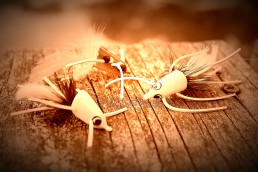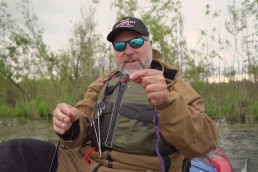Sneak Attack on Bass and Bluegills: The Popper’s Killer Dark Horse Cousin
SHARE THIS POST
If a popper is the Robin Williams fly of the bass and bluegill world, the Sneaky Pete is the Bob Newhart. Subtle. Smooth. Lesser known, though every bit as effective.
The guides on my rod hummed as a loop of fly line and leader unfurled over the water, dropping a popper just feet from a weedy shoreline framing the small farm pond. Wait. Spit. Stop. Wait. Spit. Stop. Wait. The scene had all the makings of a picture perfect strike though I stripped the popper all the way back to the boat without interruption. After five fishless attempts, I tied on a Sneaky Pete. The fly lighted on the water in the same place the popper had just moments before. Wait. Slip. Gone. A well of dark water boiled up as the line jumped to life with a bolt of tension.
The fly
The Sneaky Pete belongs to the slider family of topwater fly patterns and is the inverse of the classic popper. Its conical, bullet shaped head causes it to slip just below the surface when stripped, instead of the spitting action associated with its more commonly known cousin. Both the Sneaky Pete and popper share the tantalizing rubber legs and feather tail, giving them the profile of a terrestrial insect stranded on the water.
Paired with a five-weight fly rod and a bass leader, the Sneaky Pete can wreak havoc on a farm pond, the slack water of a stream eddy or around floating vegetation on a lake. It excels when the fish seem to turn their noses at the more ostentatious popper, but you need to know its distinctive characteristics to unleash its full potential.
The technique
Similar to a popper, a Sneaky Pete is best fished on calm water. Place the fly beyond the area you think a strike will occur, and then work it through the promising water. While it’s not uncommon for a bass or bluegill to suck it down once it lands, strikes typically come on the way back during pauses. I like to let mine sit for a ten count before stripping it in. Sometimes the sheer sight of the fly bending light on the surface will elicit a strike.
The strip ought to be determined by the mood the fish are in. As a starting point, I like short, staccato strips with long pauses. If the fish are aggressive, I’ll go for longer, more abrupt strips that disturb the water and give the fish little time to decide whether or not to strike. Kind of like the overpriced packet of jerky hanging at the register while you’re checking out.
Are you enjoying this post?
You can be among the first to get the latest info on where to go, what to use and how to use it!
When stripped, the Sneaky Pete creates a subtle, yet frantic, I-hope-nobody-sees-me wake. Sharper, more abrupt strips add a trail of bubbles that can tip an indecisive fish over the edge. The “sneak” of this fly is that it slides just below the surface, diving ever so slightly. Mats of duckweed are a perfect application for this slider. A traditional popper would foul up on the individual plants, ruining the presentation. A Sneaky Pete scoots cleanly beneath them, shedding vegetation with each strip. If the water you plan on fishing is heavy with plant life, choose a Sneaky Pete tied with a monofilament weed guard.
The take
From explosive strikes to casual sips, they’re all possible when fishing a Sneaky Pete. The key is to remain alert and ready to set the hook when you see commotion. When I think a fish has taken the fly, I’ll give one solid strip hook set with the rod pointed at the fish. While it’s possible to prematurely pull the fly out of the fish’s mouth at that angle, that hook set keeps the fly in the strike zone if the fish swung and missed. The fish gets a second chance by leaving the fly where it was left. Lifting the rod up for a hook set on a short strike will bring the fly out of the water like a back-cast. You might not get another opportunity at that fish. If fish are aggressive and smashing the Pete, lifting up on them will be your best bet.
Like any other type of sight fishing, you have to be especially patient with the strikes that you see coming. I’d rather be a split second late with a set than a split second early. An early hook set makes you a little like Lucy holding the football for Charlie Brown.
Flashing deep within that boil of water where my Sneaky Pete had been, a green streak indicated a largemouth was the culprit behind the strike. A strip set confirmed the suspicion revealing a solid force at the end of the line sending pulses of energy into my rod with every headshake. A bit of sulking on the weedy bottom, two aerial displays later, and I was lipping a great largemouth out of the farm pond. This bass wasn’t impressed with the previous brash presentations of the popper. Something about the subtlety of the Pete was more than he could take.
When it comes to fishing surface flies for bass and bluegills, the Sneaky Pete is a dark horse you can put your money on.
MWO
SHARE THIS POST
Did you enjoy this post?
You can be among the first to get the latest info on where to go, what to use and how to use it!
Tim Kjellesvik
MidWest Outdoors works with more than 200 outdoor experts each year, who contribute articles based on their areas of expertise. MidWest Outdoors magazine offers more fishing and hunting articles than any other publication!



